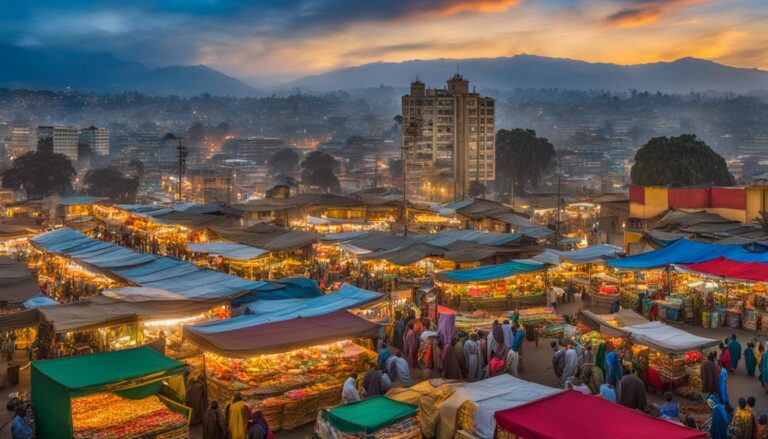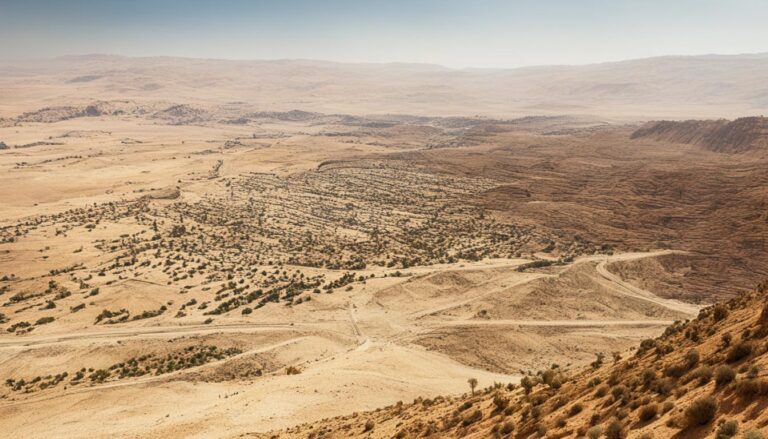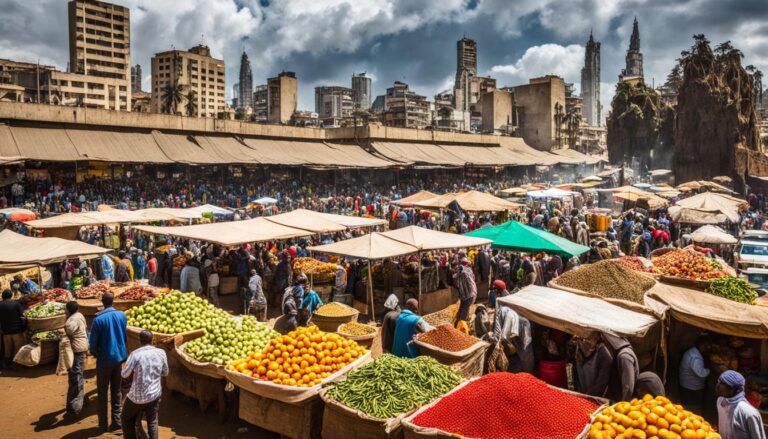What Is The Great Ethiopian Renaissance Dam (GERD)?
Overview and Significance of the Great Ethiopian Renaissance Dam (GERD)
The Great Ethiopian Renaissance Dam (GERD) is a monumental hydroelectric dam project situated on the Blue Nile River in Ethiopia. Construction of the dam commenced in April 2011 and is expected to be one of the largest dams in Africa upon completion. GERD’s strategic location gives Ethiopia control over the headwaters of the Nile River, offering significant opportunities for clean energy generation, agricultural development, and overall economic growth.
The primary purpose of the GERD is to address Ethiopia’s critical need for electricity generation. Once fully operational, it is estimated that the dam will have an installed capacity of about 6.45 gigawatts, making it a crucial component in Ethiopia’s quest for energy self-sufficiency. By harnessing the power of the Blue Nile, GERD will provide a stable electricity supply to meet the country’s growing energy demands and drive industrialization.
Moreover, the significance of the Great Ethiopian Renaissance Dam extends beyond national borders. The dam has the potential to positively impact neighboring countries by enabling better regulation of the Nile’s flow, reducing sedimentation downstream, and mitigating the impacts of droughts and floods. Furthermore, the project symbolizes Ethiopia’s aspirations for progress and development, showcasing the country’s commitment to harnessing its natural resources for the benefit of its people and the region as a whole.
The Great Ethiopian Renaissance Dam represents a transformative infrastructure project that not only addresses Ethiopia’s energy needs but also holds the promise of regional cooperation and shared prosperity. As construction progresses and the dam nears completion, it is essential for all stakeholders to engage in dialogue and collaboration to ensure that the benefits of GERD are maximized while minimizing any potential negative impacts on downstream countries.
Understanding the Potential Impacts of the Great Ethiopian Renaissance Dam (GERD) on Egypt and Sudan
The Great Ethiopian Renaissance Dam (GERD) has sparked significant concern and debate surrounding its potential impacts on downstream countries, particularly Egypt and Sudan. As the construction of the dam on the Blue Nile River in Ethiopia nears completion, both Egypt and Sudan have raised valid concerns about the possible ramifications on their water resources, agriculture, and overall economies.
One of the primary concerns for Egypt, a country heavily reliant on the Nile River for its water supply, is the potential reduction in water flow due to the filling of the dam reservoir. Egypt fears that this could lead to decreased water availability for irrigation, drinking water, and other essential needs, affecting millions of people who depend on the Nile’s waters for their livelihoods.
Sudan, situated between Ethiopia and Egypt along the Nile River, also has concerns about the GERD’s impacts. While Sudan stands to benefit from increased hydropower generation and reduced sediment flow that could improve irrigation systems, there are worries about the dam’s operations affecting its own water intake and agricultural practices.
The filling and operation of the GERD have been subjects of intense negotiations and disagreements between the three countries. Egypt has historically been wary of any developments that could potentially threaten its water security, leading to diplomatic tensions and negotiations over the filling and operation of the dam to ensure that downstream countries’ interests are protected.
Despite these concerns, Ethiopia sees the dam as a vital infrastructure project that will bring electricity to millions of its citizens and help propel its economic development. The country maintains that the GERD will have minimal negative impacts on downstream countries and is committed to reaching agreements that address the concerns of Egypt and Sudan through ongoing negotiations.
The potential impacts of the Great Ethiopian Renaissance Dam (GERD) on Egypt and Sudan remain a critical issue that requires careful consideration and sustainable solutions to ensure water security, agricultural productivity, and regional stability for all riparian nations sharing the Nile River.
The Great Ethiopian Renaissance Dam (GERD), Africa’s largest hydropower project, is a monumental infrastructure development located on the Blue Nile River in Ethiopia. The dam holds significant importance not only for Ethiopia but also for the entire region due to the potential benefits it promises in terms of electricity generation, water supply, and socio-economic advancement. As the construction progresses, the technological aspects of the dam showcase innovative engineering solutions tailored to harness the river’s immense power efficiently.
The GERD’s construction involves advanced engineering techniques to ensure its structural integrity and operational effectiveness. The dam’s design includes a roller-compacted concrete (RCC) core with a clay blanket to prevent leakage and enhance stability. Moreover, the dam features spillways and outlets to manage water flows and reservoir levels efficiently. The technological advancements in constructing the GERD reflect a commitment to sustainability and optimization of resources for long-term energy production.
In terms of construction progress, the GERD has reached significant milestones despite facing challenges such as funding constraints and technical complexities. The overall progress showcases Ethiopia’s determination to achieve energy self-sufficiency and become a major regional power exporter. The construction timeline adheres to strict quality standards and safety protocols to ensure the dam’s reliability and functionality once fully operational.
Furthermore, the GERD’s construction has garnered international attention, leading to negotiations and controversies regarding water rights and resource management. The dam’s location on the Blue Nile has raised concerns in downstream countries like Egypt and Sudan regarding water security and potential disruptions in river flow. Diplomatic efforts and negotiations are ongoing to address these concerns and establish equitable agreements on water usage and dam operations.
The technological aspects and construction progress of the Great Ethiopian Renaissance Dam highlight its significance as a transformative infrastructure project in Africa. The innovation and engineering expertise applied to the dam’s design and construction underscore Ethiopia’s commitment to sustainable development and energy security for the region. As the GERD nears completion, continued international cooperation and dialogue are essential to ensure mutual benefits and shared prosperity among riparian nations.
International Negotiations and Controversies Surrounding the Great Ethiopian Renaissance Dam (GERD)
The Great Ethiopian Renaissance Dam (GERD) has been a subject of intense international negotiations and controversies since its inception. Situated on the Blue Nile River in Ethiopia, the GERD is Africa’s largest hydroelectric power plant project. The dam’s construction, initiated in 2011, has raised concerns and disputes among Ethiopia, Egypt, and Sudan due to its potential impacts on the water flow of the Nile River.
Egypt, heavily reliant on the Nile for freshwater supply, has expressed apprehensions about the GERD’s impact on its water security. The country fears that the dam could reduce the river’s flow, affecting its agriculture and economy. Sudan, located downstream of the dam, has raised similar concerns about water shortages and potential flooding. As a result, negotiations between the three countries have been ongoing to address these shared concerns and reach a mutually beneficial agreement.
The negotiations have been mediated by various international bodies, including the African Union and the United Nations. Despite several rounds of talks and agreements aimed at resolving the disputes, challenges persist in reaching a comprehensive deal that satisfies all parties involved. Issues such as the dam’s filling and operation, water allocation during droughts, and dispute resolution mechanisms remain contentious topics in the negotiations.
Ethiopia, as the dam-building country, asserts its rights to develop the GERD as a crucial source of clean energy and economic development. The Ethiopian government views the dam as a symbol of national pride and progress, highlighting its potential to uplift millions of citizens out of poverty through increased electricity access. However, balancing Ethiopia’s development aspirations with the concerns of downstream countries has proven to be a complex challenge in the negotiations.
The controversies surrounding the GERD extend beyond water resource management to broader geopolitical implications in the region. The Nile River basin countries have historically navigated competition and cooperation over the river’s waters, reflecting power dynamics and regional alliances. The GERD’s construction has underscored these complexities, with countries seeking to safeguard their interests while promoting regional stability and cooperation.
The international negotiations and controversies surrounding the Great Ethiopian Renaissance Dam highlight the intricate balance between national development, water security, and regional cooperation. As stakeholders continue to engage in dialogue and diplomacy, finding a sustainable solution that meets the needs of all parties remains a pressing challenge in the management of one of Africa’s most vital water resources.
Environmental Concerns Related to the Great Ethiopian Renaissance Dam
As the construction of the Great Ethiopian Renaissance Dam (GERD) continues to progress, various environmental concerns have been raised regarding its potential impact on the surrounding ecosystem. One of the primary concerns is the alteration of the flow of the Blue Nile, which could disrupt the natural flow patterns of the river. This alteration may lead to changes in sediment transport, water temperature, and overall river ecology.
The decrease in sediment flow downstream due to the dam’s construction could have adverse effects on agriculture and ecosystems in Egypt and Sudan. Sediment is crucial for maintaining soil fertility and aquatic habitats in downstream regions. The reduced sediment flow might also impact the fertility of farmlands along the Nile Delta, which heavily rely on the annual flooding and sediment replenishment for agricultural productivity.
Furthermore, the construction of the GERD has raised concerns about potential water quality issues in the reservoir and downstream areas. The stagnant water in the reservoir could lead to increased evaporation, concentration of pollutants, and changes in water chemistry. These factors could negatively impact downstream water quality, affecting aquatic life and local communities that depend on the Nile for drinking water and fishing.
Another significant environmental concern is the potential disruption of fish migration routes caused by the dam. The Nile River supports diverse fish species that migrate seasonally for breeding and feeding purposes. The construction of the dam may block these migration routes, leading to a decline in fish populations and threatening the livelihoods of communities dependent on fishing along the river.
In addition to the immediate environmental impacts, the GERD could also have long-term consequences on the overall biodiversity of the region. Changes in water flow, temperature, and sediment load may alter habitat conditions for various plant and animal species along the Nile basin. This disruption could have cascading effects on the entire ecosystem, affecting not only aquatic life but also terrestrial wildlife that rely on the river for water and resources.
Addressing these environmental concerns related to the Great Ethiopian Renaissance Dam is crucial to mitigating the potential negative impacts on the ecosystem, biodiversity, and livelihoods of people dependent on the Nile River. Implementing effective environmental management strategies and conducting thorough impact assessments are essential steps to ensure sustainable development and ecosystem preservation in the region.
Conclusion
In light of the multifaceted dimensions surrounding the Great Ethiopian Renaissance Dam (GERD), it is evident that this mega infrastructure project stands as a significant symbol of Ethiopia’s ambition for sustainable development and energy security. The dam’s potential impacts on downstream countries, particularly Egypt and Sudan, have led to complex negotiations and diplomatic tensions in the region. As construction progresses, technological advancements play a vital role in ensuring the dam’s efficiency and safety. However, these advancements also raise concerns about environmental impacts and the need for sustainable management of the Nile’s resources.
The GERD’s construction represents a monumental endeavor in harnessing hydropower resources for Ethiopia’s socio-economic advancement. By providing access to clean energy and alleviating power shortages, the dam holds the promise of transforming the country’s energy landscape. Furthermore, the GERD’s strategic location on the Blue Nile underscores its pivotal role in water resource management, which has implications for downstream riparian states.
Egypt and Sudan, as downstream countries, have expressed concerns about the GERD’s potential impacts on their water security and agricultural economies. The filling and operation of the dam could affect the flow of the Nile River, posing challenges to water availability and quality downstream. Negotiations between Ethiopia, Egypt, and Sudan have aimed to address these concerns and establish a framework for cooperation in managing the Nile’s waters effectively.
Technological aspects of the GERD, including its design, construction materials, and operational mechanisms, reflect state-of-the-art engineering practices. The use of advanced technologies and international expertise has contributed to the dam’s structural integrity and operational efficiency. Continuous monitoring and maintenance protocols are essential to ensure the safe and sustainable operation of the GERD in the long run.
International negotiations and controversies surrounding the GERD have underscored the need for diplomatic solutions to transboundary water management challenges. Engaging in dialogue, building trust, and fostering cooperation among riparian states are essential for addressing shared concerns and maximizing the benefits of the Nile’s waters. The involvement of international mediators and organizations can facilitate productive discussions and enhance the prospects for regional stability and development.
Environmental concerns related to the GERD encompass a range of issues, including the dam’s impact on river ecosystems, biodiversity, and downstream habitats. Mitigating these concerns requires comprehensive environmental impact assessments, sustainable land management practices, and biodiversity conservation measures. Balancing the ecological footprint of the dam with its socio-economic benefits is crucial for ensuring the long-term sustainability of the Nile River basin.
The Great Ethiopian Renaissance Dam embodies both the opportunities and challenges inherent in large-scale infrastructure development projects. Its significance extends beyond energy generation to include water security, regional cooperation, and environmental sustainability. By addressing the complex issues surrounding the GERD through dialogue, innovation, and responsible management practices, Ethiopia, Egypt, and Sudan can harness the dam’s potential to drive inclusive growth and prosperity in the region.




